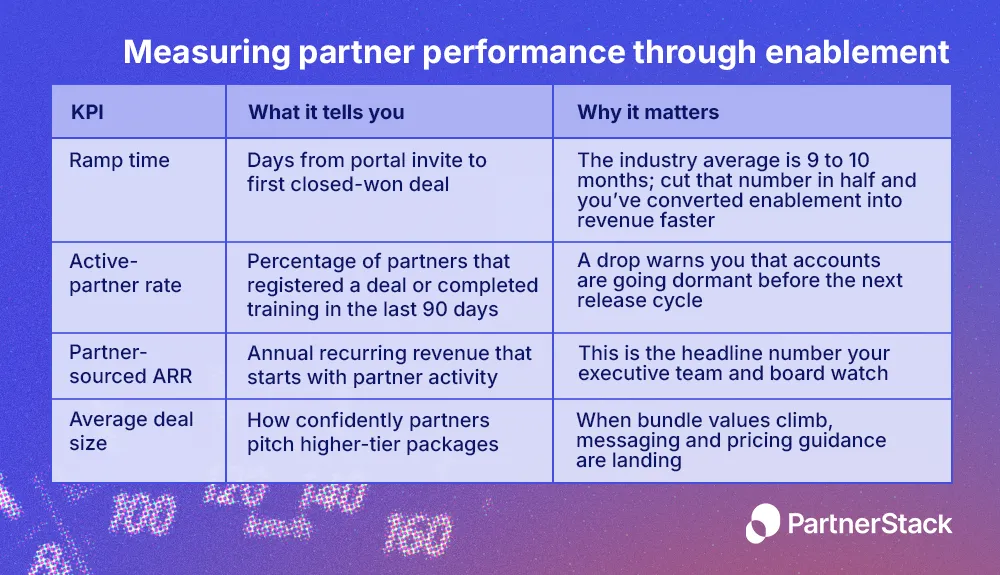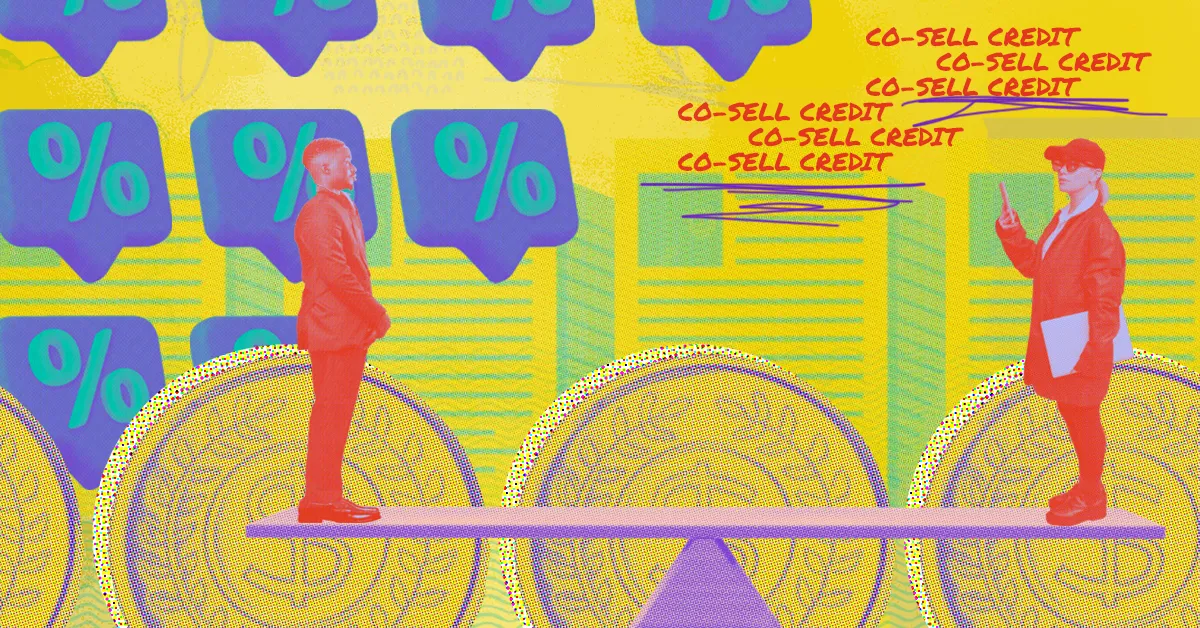Have one of the following scenarios ever happened to you?
- Your partner over promises during a sales pitch and you have to spend the rest of the call backpedaling.
- Your partner forwards you an email asking how to respond to a prospect — it’s a product question they should absolutely know the answer to.
- You bear the brunt of negative customer feedback from a partner-led implementation gone wrong.
This is the stuff of partner manager nightmares. Yet, these scenarios aren’t uncommon.
Companies often jump straight into doing business without taking the time to enable their partners, especially given the pressure partner leaders are under to drive revenue.
But trying to push partners into selling without any training or marketing materials is like telling a pre-med student to jump into an operating room.
So, how do you do enablement right? We spoke with PartnerStack’s Senior Customer Success Manager, Nima Hafezi on just that.
In this article, we will explain why a sound partner enablement strategy matters in 2025 asnd share how the best vendors set their partners up for success.
What is partner enablement in 2025?
Partner enablement is the practice of equipping external sellers, affiliates or service providers with the knowledge, resources and support to position, sell and implement your solution at the same standard as your in-house sales team.
A good partner enablement program today gives your partners — from co-sell, to influencer and affiliates — everything they need to succeed: a self-serve portal, bite-sized training, co-brandable decks, sandbox access and support whenever a deal’s on the line.
Notably, channels such as partners and strategic alliances have become indispensable as they move around 75 per cent of all trade now, according to Forrester.
But do note that partner enablement is different from sales enablement.
Sales enablement, in contrast to partner enablement, focuses on your own account executives. Partner enablement is the mirror. It packages the same insights, such as positioning, pricing and implementation know-how, for professionals who carry someone else’s badge.
Why does partner enablement matter?
On the surface, partner enablement seems like it’s about providing partners with basic education.
But really, it’s about establishing trust.

The more of these boxes you check, the more confident partners will feel in your support and the more they will want to engage with your program.
Hafezi emphasizes, “Partners can tell right away if a vendor is on top of it or new to the space. Making a great first impression gives the partner faith in the future success of your partnership.”
Related: Why partner education can make or break your partner program.
The benefits of top-notch partner enablement
Trust opens the door to possibilities beyond a preliminary exchange of leads or rev share. In a trusting partnership, you can:
- Request (and receive) candid feedback on your program or new product features
- Feel more comfortable relying on certain partners when entering a new geo
- Share strategic insights about specific verticals you want to move into
- Trial new offer types or partner types
“Building deep trust in your partner relationships opens your horizons,” says Hafezi. “You know that when you show partners something new, they’re not going to try to game the system — they’re going to help you make your program the best it can be. That’s the mutual benefit.”
Perhaps most importantly, building deep relationships builds partner loyalty and helps you retain your best partners over time.
You might also like: Why channel partners quiet quit partner programs (and how to win them back).
The components of an effective partner enablement strategy
An airtight partner program boils down to three pillars: onboarding, collateral and continuous training.
Together, they must answer the what, why, and how that will equip your partners with the same confidence as your direct sales team.
Onboarding
If a new partner hasn’t started marketing or selling within 90 days of signing up for your program, the relationship is likely to stall forever, reports Forrester
That makes your first touchpoints very delicate.
A crisp, role-based partner onboarding flow is hence necessary. It should include:
- A kick-off call that sets partnership terms, targets and next-step owners.
- Interactive product walkthroughs with sandbox access so reps can tinker, break things and learn your product quickly.
- Certification checkpoints, like short quizzes or demo recordings, that prove mastery before a solo customer call.
- Who-to-ping cheat sheet covering legal, technical and marketing contacts with real names, not generic inboxes.
Partners need to be able to walk away from day one, knowing exactly where to find answers and how to hit quota.
Collateral
Once orientation ends, your partners need assets they can drop straight into prospect conversations.
Therefore, it makes sense to have a searchable library stocked with:
- Co-brandable pitch decks and one-pagers
- ROI calculators tied to your pricing logic
- Customer stories and battle cards updated with every release
You’ll have to treat this library as your living documentation. Ship updates the same day product notes go out, so your partners never pitch outdated or invalid value propositions.
Related: See revenue-driving partnerships in action with real-world case studies.
Training materials
Great product training is the first step to a partner being able to successfully sell SaaS.. Therefore, you must invest time in creating suitable training material to help partners succeedr.
You may consider creating partner learning paths, short video modules, live ask-me-anything sessions and scenario-based labs to give partners multiple ways to learn about your product or solution.
Ongoing learning keeps partners sharp, enabling them to stay current with new features and market shifts. That’s often what sets the best partner programs apart from the rest.
Building a scalable partner enablement program
So far, we are good with the fundamentals — impactful onboarding, living collateral and an always-on training loop that mirrors your direct sales motion.
The next challenge is scale. PRM spend alone is projected to hit $45B in 2025 as vendors hunt for tools that keep larger ecosystems running.
Here’s how you grow without losing the consistency you’ve worked so hard to create.
Segment partners the right way
Some partners will need a lot of hand-holding. Managed service providers and implementation partners, for instance, need technical knowledge and domain expertise to give customers an outstanding experience.
Other kinds of partners, like affiliates, may not require in-depth training. They just need your sales and marketing assets, MDFs and challenges to get their pipelines moving.
Sorting your partners into various groups forces you to think hard about what they need to know and how they’ll best consume it.
Hafezi highlights: “Every partner has a level of effort they’re willing to put forward,” Hafezi explains, “Publishers, for example, have a lot of leverage and influence, so you’ll likely have to modify your enablement process to meet their expectations.”
One way is to group your partners by business model, and it’ll be easy for you to figure out their marketing budget, time constraints, product knowledge and the way they work.
- Co‑sell partners thrive on joint selling motions; give them shared opportunity dashboards, joint account‑planning templates and explicit revenue‑share structures.
- B2B influencers and content creators can greatly extend your brand’s reach. Arm them with ready‑to‑use creative assets so they can generate relatable stories that create demand.
- Resellers and VARs want pricing sheets, quote tools and competitive comparisons since they transact the deal.
- Referral partners influence the decision, so quick-pitch decks and simple lead-handoff forms keep them productive.
- Distributors benefit from localization kits and inventory visibility.
- Systems integrators insert products into broader solutions, so API docs, sandbox access and architecture diagrams matter most.
- Managed-service providers need implementation guides and escalation paths.
Moreover, pair content, certifications and incentives with each segment’s workload. Newcomers need to see only what they need for first wins; veterans should have access to deeper technical tracks.
Over time, you may want to segment even further within your groups. For example, into several sub-categories — inactive, active, new and non-revenue-generating — to create specific offer structures, SPIFFs and email sequences that can motivate each.
Build enablement journeys for each segment
Once you’ve got your partners in groups, it’s time to figure out which content and training is most suitable for them.
For some inspiration, here’s a list of enablement strategies Hafezi tends to see work well:
- Onboarding: Welcome emails or partner portal tutorials help guide partners through how your program works, how they earn money and the high-level value prop of your product or service.
- Structured communication: Relatively constant communication with partners shows that you’re invested in their success. But remember, communications should also show your appreciation. “Try triggering emails off of certain milestones, like a first sale, so you can be the first to congratulate a partner on a job well done,” Hafezi suggests.
- Marketing resources: Brochures, logos, case studies and social content all help partners message your product to prospects. Hafezi notes, “Shared case studies get particularly good traction.” Be sure to group relevant content together so it’s easy for partners to find what they need.
- Co-brandable templates: Partners want to showcase their relationship with you, and there’s no better way to do it than through co-branded content. In a platform like PartnerStack, you can allow partners to co-brand PDF templates, publish them to social media and measure campaign performance themselves.
- Training: Training courses give partners the technical knowledge and credibility they need to sell your product. Most companies use a learning management system (LMS) or a PRM with a built-in LMS to deliver this kind of training, but you don’t have to go the online route.
- Gamification: Partners want something to work toward. Tiered incentives and time-bound challenges light the fire that partners need to complete their training or start reeling in leads.
Follow a repeatable lifecycle rhythm
Because your product and GTM strategies are always in flux, enablement will be an ongoing process.
Scaling, too, is easier when every partner moves through the same clear sequence:
- Recruit: Set concrete revenue targets in the first call.
- Profile: Capture vertical focus, headcount and tech stack so onboarding feels relevant.
- Onboard: Provide role-based lessons on product, pricing and deal registration.
- Certify: Use short tests or demo recordings to approve partners for independent selling.
- Co-sell and co-market: Run joint campaigns and hold shared pipeline reviews to maintain momentum.
- Quarterly Business Review (QBR): Revisit performance data, reset goals and identify new growth areas.
See more: Quarterly business reviews guide for partnership teams.
Direct partner feedback is an excellent way to gather ideas for new campaigns and offers and develop new and exciting content. Setting up regular check-ins is a good way to prompt feedback.
Nima notes, “Some partners might not be as vocal when they’re struggling until you meet face to face. A few tweaks to their enablement path can get them back on track and even turn them into some of your best partners.”
And because the process is transparent and consistent, partners always know the next milestone, and your team can manage dozens, or even hundreds, of relationships smoothly.
Give everyone a unified, continuously updated home-base
The easiest way to keep dozens of partners on the same page is a modern portal. Instead of a messy chain of PDFs and emails, they sign in and immediately see:
- role-based learning paths and certifications
- co-brandable decks and one-pagers that update when product notes do
- deal-registration forms that sync straight into your CRM
- live status and analytics that pinpoint problem areas
If you prefer something ready-made, PartnerStack wraps all those functions into one dashboard built for B2B SaaS. Partners can complete templated onboarding, pull the latest collateral as soon as a release ships, register deals that sync straight into your CRM and trigger automatic payouts.
Learn more: The future of co-sell doesn't start in a PRM, it starts where your partners work.
Tools that support partner enablement
Most sales-enablement suites were built for people who sit inside your Slack workspace. They nail call coaching and content suggestions, but they assume a rep can tap a teammate when things get tricky.
Partner-enablement platforms like PartnerStack start where sales tools stop.
It adds automatic co-branding, tier-based permissions, joint dashboards and certification systems so outsiders can move a deal forward without your intervention.

PartnerStack is the ready-made version of that right-hand column. The PRM bundles recruiting, automated onboarding, resource sharing, deal tracking and payout automation into one dashboard, so no more swivel-chairing between apps and workflows.
Those built-in analytics also tell you the numbers you’ll use to judge performance. And that’s where we’re headed next: measuring partner success through enablement.
Why your enablement strategy must align with the sales process
Ultimately, your partner enablement efforts must be in sync with how your sales team sells so that every asset lands at the right moment.
That alignment with your sales process matters more than you think:
- Roughly 65 per cent of marketing content never reaches a prospect because sellers can’t find it or don’t see the point. This is an all-too-common side effect of disconnected processes.
- Partners need to instantly know which piece to send when a deal moves from discovery to evaluation. So, lay down each course, checklist and deck to the same buyer-journey stages your account executives use.
- If a reseller uploads proof-of-concept notes, your managers need to see it in real-time, just as they would for an in-house rep. You need to pipe partner activity into your CRM so everyone looks at the same dashboards.
- The quicker you update partners about product or pricing changes, the fewer mixed messages land in front of prospects. You need to schedule an immediate content push to partners.
Consistency comes naturally when partner touchpoints align with each stage of your sales cycle. With that foundation secure, you can now build a partner-enabling program that scales smoothly as new partners join.
Measuring partner performance through enablement
Finally, you have to measure your efforts, and great enablement definitely shows up in the numbers.
Healthy programs let you see whether enablement is doing what we designed it to do in two ways: they move partners from onboarding to first deal without friction, and they turn that activity into steady, renewing revenue.

Track the set monthly. Celebrate improvements, flag back-slides and tighten training or incentives before small snags become revenue leaks.
Related read: Partner program KPIs: The metrics you should measure and optimize
Close the loop with feedback and usage data
Numbers alone don’t show why something slips. Short pulse surveys after each module will grab raw feedback while it’s still fresh; quarterly business reviews layer that sentiment over KPI trends to decide what to refine, retire or double down on.
Because your portal syncs usage to revenue dashboards, you can see that partners who watched the new demo video, for example, close deals 15 per cent faster.
Moreover, most programs will add ten times as many partners in 2025, and 80 per cent of them won’t transact directly. Rigorous measurement is the only way to keep that growing ecosystem healthy.
That just leaves us with one question:
Do you need a partner enablement manager?
The short answer is no, particularly if you have a small program with few partners.
That said, a lot goes into designing and constantly updating your partner enablement program, and distributing that work among partner managers may not be your best bet. If you don’t have the budget to hire another FTE, you could nest enablement under a partner ops function.

Bringing partner enablement full circle
Partner enablement is everything we’ve talked through: onboarding, collateral, continuous training, shared data and the exact right tools for the job.
Get those working together and partners become an extension of your team, bringing you revenue you’d never achieve alone.
PartnerStack consolidates the entire partner enablement framework into a single platform, including learning paths, brandable assets, payout automation and everything else you need to keep your partner ecosystem strong.
Book a demo and turn partners into steady, predictable revenue.
















